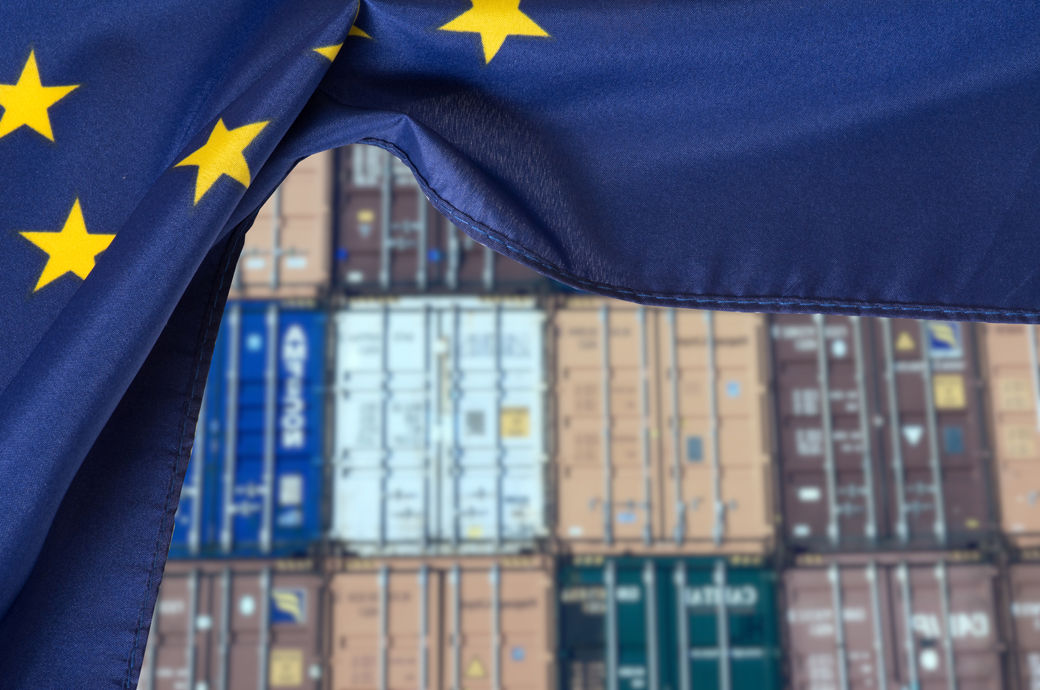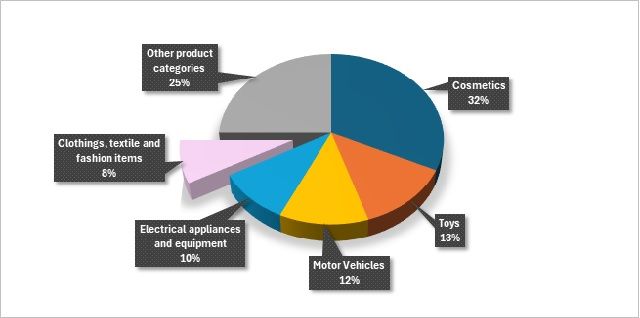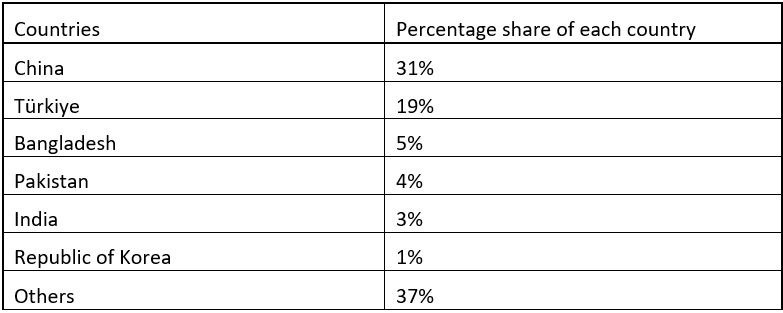
Safety Gate is the EU's rapid alert system designed to protect consumers by facilitating the swift exchange of information about dangerous products across member states. When a product is identified as posing a risk—whether due to safety hazards or non-compliance with regulations—the system allows countries to notify each other and coordinate the removal of the product from the market. This proactive approach helps prevent consumer harm by ensuring that products posing risks, such as choking hazards or chemical dangers, are quickly identified and addressed.
Exhibit 1: Safety Gate’s most reported non-compliant products for CY 2023 (in %)

Source: Safety Gate
Regarding textiles, Safety Gate addresses safety concerns by monitoring and alerting member states about clothing, textiles, and fashion items that pose risks to consumers. This includes identifying products that may have safety issues, such as choking hazards from small detachable parts, strangulation risks from functional cords, or chemical hazards from toxic substances. When a dangerous textile product is detected, Safety Gate facilitates the rapid dissemination of information among EU countries, enabling coordinated action. This often involves recalling or withdrawing unsafe products from the market, ensuring that consumers are protected from potential injuries or health issues related to textile products.
As of 2023, clothing and textiles remain a prominent category in the import reports of several EU countries, highlighting significant concerns for exporters in this sector. The European Union, as a major consumer market, imports more textiles than it exports, and the scrutiny of these products is particularly stringent. Textiles, including children's clothing, are subject to rigorous checks due to their widespread use across different demographics and the heightened sensitivity required for products intended for children.
Among the EU nations, Bulgaria, Cyprus, Estonia, Greece, Iceland, Lithuania, Norway, Italy, and Romania report clothing and textiles as one of their top three most frequently reported import items. Notably, Bulgaria has the highest reported rate for clothing and textile imports, with 39 per cent of such items being flagged. Cyprus follows with a significant 35 per cent of textile imports being reported compared to other categories.
Further analysis reveals that countries such as Hungary, France, and Ireland also prominently report issues related to clothing and textiles. These countries, leading performers in the EU, import textiles from various sources. Hungary, for instance, predominantly sources textiles from fellow EU members like Germany, Poland, and Austria, while countries such as China, Bangladesh, and India are among the top 20 exporters to Hungary. France and Ireland also import textiles from Asian countries, including China, India, Türkiye, and Bangladesh, which feature prominently in their top 10 exporter lists.
Trends for 2024 indicate a need for heightened vigilance regarding safety alerts in textiles. It is crucial for these leading textile-importing nations to closely monitor and address safety concerns to ensure compliance with EU standards and maintain market integrity.
Trends for the year 2024 (January-August)
Table 1: Countries featured in the list of most reported, non-compliant exports to the EU (by %)

Source: Safety Gate, F2F Analysis
Approximately 78 cases have been reported for the year 2024, from January to August. Of these, 31 per cent of the reported imports are from China, with Türkiye being the second-largest source, accounting for 19 per cent of the imported clothing and textiles. Other Asian countries, such as Bangladesh, Pakistan, and India, also appear on the list but contribute much lower percentages. The remaining 37 per cent mainly consists of numerous countries including Italy and Belgium.
Most of the clothing and textile products fall under the baby apparel segment, while only 14 of the 78 total products are in categories such as trousers, gloves, dresses and sweatshirts.
Frequently mentioned risks for CY 2024
The most frequently mentioned risk in the product descriptions is strangulation. This risk primarily concerns products with long functional cords or drawstrings, especially those located in the neck area, which can become trapped and tighten around a child's neck, posing a severe danger of strangulation. Closely following is the risk of injuries, often associated with long drawstrings or functional cords in the waist area, which can become caught during various activities, potentially leading to injuries. Choking hazards are mentioned twice, related to small decorative elements that can detach and pose a risk to young children. Additionally, there are two mentions of chemical risks, specifically chromium VI, which can trigger allergic reactions and cause cancer. Lastly, there is a single mention of the risk of burns due to insufficient UV protection in swimwear.
It is important to understand the violations caused by these clothing and textile products. The General Product Safety Directive is the most frequently cited provision, accounting for 51.22 per cent of the cases listed. Following closely is the General Product Safety Directive EN 14682, which appears in 35.37 per cent of the instances. The REACH Regulation, while less prevalent, still plays a notable role, appearing in 4.88 per cent of the cases. This distribution underscores the significant emphasis on general product safety regulations and their specific standards, with the REACH Regulation being a less common but important consideration.
The General Product Safety Regulation (Regulation (EU) 2023/988), effective from June 12, 2023 and fully enforceable by December 13, 2024, enhances consumer protection for non-food products, including clothing and textiles. It imposes stringent safety standards to address risks related to hazardous chemicals, allergens, and unsafe features. The regulation mandates clear labelling with information on materials, potential risks, and care instructions. It also empowers national authorities to inspect products, request information, and take action against non-compliance. For online shopping, the regulation ensures that textiles meet EU safety standards and that online marketplaces enforce compliance, facilitating recalls and safety warnings. Manufacturers and distributors are required to conduct risk assessments and report safety issues to enhance market safety.
European Standard EN (European Norm) 14682 focuses on the safety of children’s clothing, specifically targeting cords and drawstrings. It sets strict limits on the length and type of these elements to prevent strangulation and entanglement hazards for children under 14. The standard also requires clear labelling and consumer information to support safe garment use, ensuring that products adhere to safety criteria and protect children from related injuries.
The REACH Regulation (Regulation (EC) No 1907/2006), which stands for Registration, Evaluation, Authorization, and Restriction of Chemicals, governs the use of chemicals in clothing and textiles within the European Union. Under REACH, manufacturers and importers must register the chemicals used in their products, including textiles, to ensure they do not pose health or environmental risks. The regulation requires thorough safety assessments and authorisations for hazardous substances, aiming to restrict or ban the use of harmful chemicals in consumer products. For textiles, this includes ensuring that any chemical treatments, dyes, or finishing agents meet stringent safety standards to protect consumers from exposure to potentially dangerous substances. REACH also mandates clear communication of chemical risks through labelling, allowing consumers to make informed choices and enhancing overall safety in the textile market.
Persistent Organic Pollutants (POPs), EN 71-1, and EN 13758-2 are also regulations violated by textiles and clothing imported into the EU.
In conclusion
Exporters in India and other countries should align their safety regulations with EU standards to ensure compliance and maintain market access. The EU is a crucial market for various clothing items, particularly baby apparel, which has stringent safety requirements. It is essential for countries like India, whose major apparel exports include baby clothing, to focus on meeting these specifications to avoid penalties and market restrictions due to non-compliance.
Countries such as China, Turkiye, and Bangladesh have faced consistent reports of non-compliance in the current calendar year. Leading textile-exporting nations must assess the risks associated with their products and understand the legal requirements to ensure their goods meet EU standards. By doing so, countries like India and Pakistan, which export significant volumes of textiles to the EU, can develop sustainable and safe textile solutions that comply with EU regulations.
Fibre2fashion News Desk (NS)
Receive daily prices and market insights straight to your inbox. Subscribe to AlchemPro Weekly!